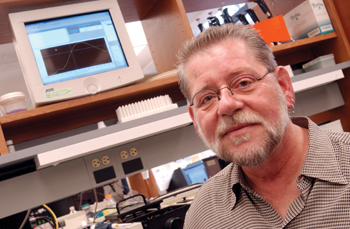
Paul Bock, Ph.D. is studying how a bacterial protein might participate in the pathology of endocarditis. Dana Johnson
Protein structure offers insight on heart infections
Acute bacterial endocarditis — infection of the heart’s inner lining or valves — can be deadly, even with antibiotic treatment. Vanderbilt University Medical Center investigators, in collaboration with a team of German researchers, have discovered how a bacterial protein activates the blood-clotting system, promoting the overgrowth of clot-like “vegetations” in the heart. Blocking the protein’s activity could provide a new therapeutic approach for treating bacterial endocarditis.
The protein is staphylocoagulase, a product of the bacteria Staphylococcus aureus, often called “staph.” Staph bacteria are commonly carried on the skin or in the noses of healthy people, and they are one of the primary causes of acute bacterial endocarditis.
Some strains of staph bacteria pump out the staphylocoagulase protein, which activates the blood-clotting protein prothrombin to ultimately produce fibrin, an insoluble protein that holds blood clots together. The staphylocoagulase activity becomes problematic when the staph bacteria have latched onto a tiny area of damage on a heart valve or elsewhere in the heart’s endothelial cell lining, said Paul E. Bock, Ph.D., associate professor of Pathology and Medicine.
“You end up with something called a vegetation — a layering of fibrin, platelets and bacteria,” Bock said, “and these things grow.” Because the vegetations are loosely held together, small chunks can break off, setting up new sites of infection elsewhere or causing heart attacks or strokes.
Staphylocoagulase is a primary contributor to the growth of the vegetations, Bock said, and it is not blocked by any of the normal anti-clotting factors present in the body.
“This molecule is a very nasty customer; you can’t stop it,” Bock said. If you could, he added, it might be possible to slow or block the growth of vegetations, which are thought to contribute to the high mortality rate — 25 percent, even with antibiotic treatment — of acute bacterial endocarditis.
Bock and his collaborators have some new ideas on how to block staphylocoagulase, based on their studies published Oct. 2 in Nature. Bock and graduate student Peter Panizzi, working with Rainer Friedrich, Robert Huber and Wolfram Bode at the Max-Planck-Institut für Biochemie in Martinsried, Germany, solved the structure of staphylocoagulase bound to a form of prothrombin called prethrombin 2. The new pictures of how the staphylocoagulase protein interacts with and activates prethrombin 2 give the investigators leads on designing inhibitors to block the interaction, Bock said.
The structure also confirmed a hypothesis that Bode and Huber proposed 27 years ago to explain how streptokinase — a different bacterial protein — activates the protein plasminogen to form the clot-dissolving enzyme plasmin.
Plasminogen, prothrombin, and a host of other “serine proteinase zymogens” (zymogens are inactive forms of enzymes) are normally activated by having one link in the protein chain cut. One end of the clipped chain then inserts into a binding pocket in the body of the protein to induce a change in the protein’s structure and activate it. Streptokinase and staphylocoagulase activate their respective zymogens in a unique way, without cutting the proteins.
Bode and Huber proposed that streptokinase embraces plasminogen and inserts its own end into the binding pocket that normally accepts the end that is produced when plasminogen is cut. They termed this concept the “molecular sexuality mechanism.” The new structural information proves that this mechanism holds true for staphylocoagulase and prothrombin.
“We like to think of it as a moment of passion between consenting molecules,” Bock said.
Prior to the current studies, staphylocoagulase and streptokinase were the only proteins known to activate serine proteinase zymogens in this unusual manner. Using the new structure to conduct searches of protein databases, the researchers found another four bacterial proteins with a staphylocoagulase-like activation motif along with an adhesion domain. Bock is particularly interested in these proteins and the zymogens they could potentially activate.
“We think that the members of this new family of proteins may play a part in these kinds of infections where you end up with vegetative growth,” he said. Like staphylocoagulase, he added, these other family members may be good targets for drugs designed to fight infections like endocarditis.
Bock’s efforts to understand the nuances of how staphylocoagulase activates prothrombin and to explore the new members of this larger family have been rewarded with a National Institutes of Health MERIT (Method to Extend Research in Time) award.
The MERIT award was a surprise, he said, since these awards are usually reserved for ongoing research programs. The staphylocoagulase project was a new grant proposal.
“The MERIT award is a big honor, and I’m grateful,” Bock said. “It will really give us the freedom to run with our ideas.”
Among the co-authors of the Nature study are Ingrid Verhamme and Patricia J. Anderson at Vanderbilt. The research was supported by the National Institutes of Health, the EU project SPINE and the Fonds der Chemischen Industrie.













